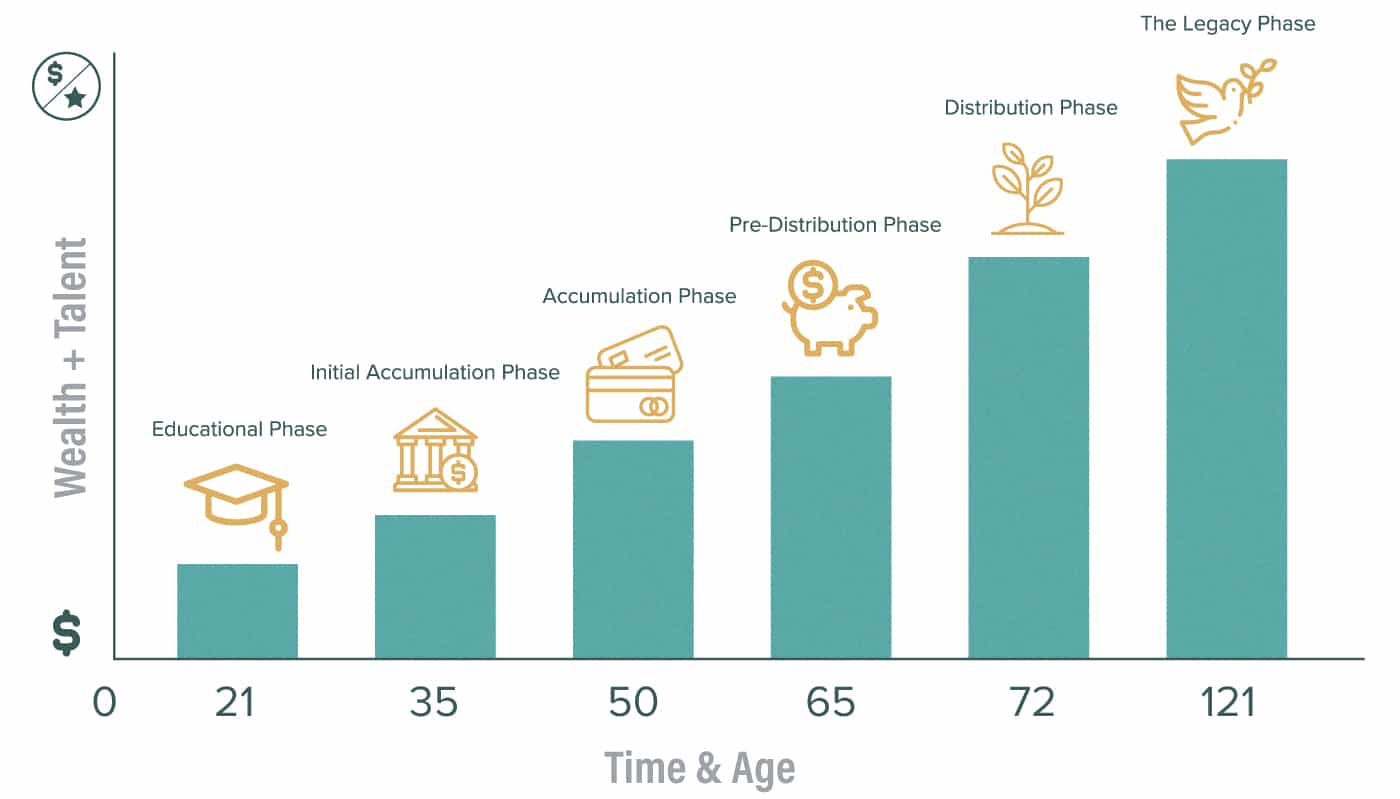Most financial institutions teach the rule of 100. We subscribe to the idea that economists say you may live a long time… therefore plan as such using the KP121 Rule.
The KP121 Rule™ focuses on the Accumulation, Distribution, & Legacy Phases using the KP Financial Model™ to verify the APPROPRIATE BLEND with instruments of actuarial science & investments over your financial journey.
To understand the appropriate blend of actuarial science and investments, we must explore the age-appropriate, asset appropriate, income appropriate timeline to manage the balance of risk/reward.

0-21 Education Phase
- This is where solid money relations are taught preparing individuals for the Initial Accumulation Phase (IAP)
- As you age the burden of protection and the need to save for the pre-accumulator shifts from the caregiver UNLESS special needs exist
- Very little to no focus is necessary for protecting personal assets at this phase
- Very little to no focus is necessary to protect income in this phase
- Until assets accumulate beyond the max acceptable loss of the provider, there will be little need or want to provide protection over the pre accumulators life
- Maximize tax-free, tax-preferred vehicles & instruments
21-35 Initial Accumulation Phase
- Protection
- This phase is designed around protecting future income producing potential
- The likelihood of a young person in the IAP phase is much more likely than premature death
- This creates the need to protect income earning ability greater than in the later accumulation years
- In this phase, individuals build family and create more of the need to protect the ones they love
- Savings
- The principle of paying yourself first
- Goal of saving 15% of gross earnings
- Tax-free, tax-preferred, tax-deferred in this order IF you believe taxes will be higher in the future
- Diversification of savings should consist of 70-80% at risk, and 20-30% in safe money assets (24 months of cash flow)
- Growth
- This is the ownership component
- Real estate, first-time homebuyer, understanding the use of proper leverage at 75-100%
- Build wealth with credit & leverage potential
- Expansion of liquidity, use, and control of assets
- A strategic balance of risk/reward
- Works with an investment advisor to develop an investment policy
36-72 Pre Distribution Phase
- Protection
- 36 → 55 Protect Income
- 56 → Life Expectancy Protect Assets from long term care events
- Protect Assets from liability
- Protect assets and income from disability, medical, long-term care & risk of longevity
- Protect Assets, Income & Life
- The eroding factors of wealth examples
- Premature death
- Planned obsolescence
- Increased Income Tax
- Inflation
- Long-term Care events
- Technological change
- The eroding factors of wealth examples
- Savings
- Build on to 24-month cash reserve (the 3-5 day money access)
- Continues to save 15+% of income (any excess of the standard of living money)
- Goal to reach 100% tax-free distribution phase
- Maximize the efficient match from the employer or your business
- Avoids consumer debt
- Utilizes efficient arbitrage
- Begin to review the use of leverage for cash flow aka. Rev. mtg, SPIA’s, etc…
- Growth
- 3% – 4% minimum shift to non-correlated assets
- Real Estate Ownership grows
- Continue development of investment policy with investment advisors
- Maximize liquidity, use, and control of all assets (ie. cash value) (tax-preferred growth instruments)
- Shifting to more tax-preferred & tax-deferred volatility controlled instruments
- 3% – 4% minimum shift to non-correlated assets
72-121 The Legacy Phase
- Protection
- The goal of a 1-1 ration between protection of assets & value of assets
- To protect income & assets
- Volatility control instruments
- Pensions
- Social Security, SPIA’s, Fixed Indexed Annuities, and Deferred Annuities
- Have adequate life insurance to cover long-term care events and replace assets needed for those expenses
- Savings
- Starts exercising minimum to maximum distributions from qualified retirement instruments
- Seeks to stabilize or grow cash equivalents to beyond 24 months
- Seeks to maximize the use of distributions in every tax-free asset available
- Distributes necessary standard of living cashflow
- Growth
- Align assets for maximum enjoyment of wealth w/o risk of running short
- Maximize volatility control
- Minimize the risk of loss
- Utilize real estate strategies for max L.U.C
- Develop investment policy w/IA for max distributions for maximum enjoyment
KP121 Rule™ focuses on the Accumulation, Distribution, & Legacy Phases using the KP Financial Model™ to verify the APPROPRIATE BLEND with instruments of actuarial science & investments over your financial journey.

